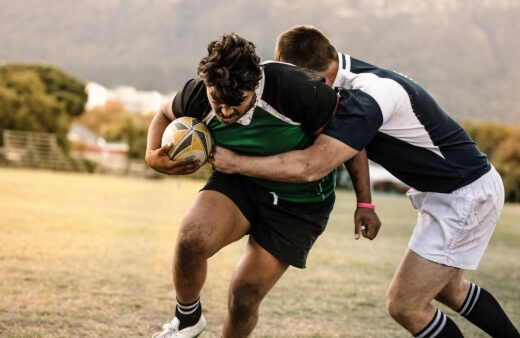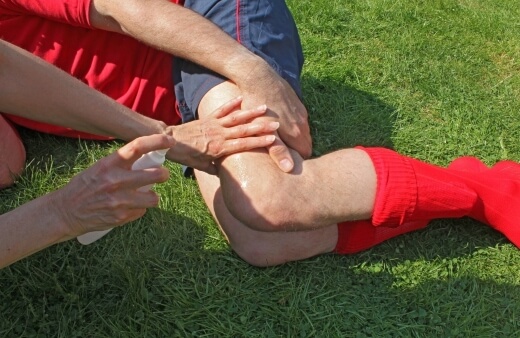Rugby league is the leading professional team sport in Queensland and NSW. It is a high speed, full contact sport that is all too familiar to injuries. Half of the injuries reported are to the lower limbs, while the other half are to the upper body.
Most common rugby league injuries occur from impact and collisions. Immediate and correct diagnosis of these injuries is critical for treatment and rehabilitation.
Prevention and Treatment of the 5 Common Rugby League Injuries

1. Medial Collateral Ligament Tears
What are MCL Tears?
A Medial Collateral Ligament Tear is often referred to as an MCL injury. The Medial Collateral Ligament runs along the inner edge of the knee. The injury can occur when the outside of the knee receives a direct hit.
MCL Tear Prevention
Knee injuries are not always avoidable, but you can help prevent them. The best way to prevent an MCL injury is to strengthen the muscles around your knee. These strong muscles will help support the knee and prevent injuries.
MCL Tear Treatment
Minor MCL strains often heal on their own with ice, rest, and non-steroidal anti-inflammatory drugs. Severe MCL tears will require physical therapy to strengthen the leg muscles.
In rare instances, surgery may be required.
2. Sprained Ankle
What is a Sprained Ankle?
A sprained ankle can happen when you twist your ankle and overstretch or tear the ligaments. Sprained ankles are common in fast paced sports.
Sprained Ankle Prevention
You can help prevent an ankle sprain by practising proprioceptive training and strength training. Ankle taping is also recommended to add additional support. Here are some ankle strengthening exercises.
Sprained Ankle Treatment
Ankle sprains should be examined by a specialist. You will need to have an x-ray to determine there are no other fractures. Serious injuries may require surgery. But in most cases, your doctor will recommend rest, ice, compression, and elevation to relieve the swelling, pain and discomfort.
Rugby League players should work with a physiotherapist to help restore motion, improve strength, decrease pain and swelling, and improve balance.
3. Dead Legs

What is a Dead Leg?
A dead leg is an extremely painful injury. The injury happens when there is an impact to the quadriceps. The impact smashes the muscle against the bone causing damage.
Dead Leg Prevention
Since Rugby League players wear little to no padding, it is almost impossible to prevent dead legs. However, by following a well-balanced diet and drinking plenty of water, your muscles will become supple and more resilient.
Dead Leg Treatment
Dead legs are caused by a damaged muscle. So, you should not return to playing too soon. A specialist should run an examination which may include ultrasound scans and imagery.
Treatment of dead legs includes rest, ice, compression and elevation. Your doctor may also have you see a physiologist to get a personalised rehabilitation program.
4. Rotator Cuff Injuries
What are Rotator Cuff Injuries?
The group of muscles and tendons that keep your shoulder in the socket are known as the rotator cuff. Most rotator cuff injuries in rugby league players are sprains and tendonitis.
Rotator Cuff Injury Prevention
The best way to prevent rotator cuff injuries is by performing daily shoulder strengthening exercises. It is important that all the muscles in the chest, shoulders, upper arms and upper back are equally worked out.
At SSEP, our Physiologists can create you an exercise plan that will help you prevent rotator cuff Rugby League injuries.
Rotator Cuff Injury Treatment
If a player has a rotator cuff injury, a specialist will examine the injury. They will perform a physical exam that may include an x-ray, ultrasound or MRI. If surgery is needed, a player should not continue playing.
Delaying surgery can lead to permanent joint damage. Pain can often be treated with ice packs and non-steroidal anti-inflammatory drugs. If the pain is severe, steroid injections may be recommended.
Physiotherapy is often recommended for Rugby League players who have a rotator cuff injury. Exercises are tailored to each player to help restore strength and flexibility.
5. Dislocated Shoulder

What is a Dislocated Shoulder?
A dislocated shoulder is the most common injuries in rugby league. The shoulder can become dislocated when a player is tackled or falls. In most cases, a medical expert can put the shoulder back in place without surgery.
When a player suffers from a dislocated shoulder, the area needs to be x-rayed. This will give the doctor the ability to determine if there is any additional damage.
Dislocated Shoulder Prevention
Rugby League is a physical sport and shoulder injuries are common. These injuries are hard to prevent. However, league players should work on strengthening the muscles in their shoulders.
A player that has strong shoulder muscles are less likely to experience a dislocated shoulder.
Dislocated Shoulder Treatment
X-rays should be taken when a Rugby League player has experienced a dislocated shoulder. This will rule out any other injuries. Once the shoulder is put back into place, the pain should go away.
If the shoulder is injured, surgery may be required. A sling will need to be worn for a few weeks after the surgery. Once the shoulder begins to heal, strengthening and rehabilitation are essential.
Many patients need pain relievers and/or muscle relaxants throughout the healing process. Once a player has had a dislocated shoulder, Physiotherapy is often recommended.
Therapy will help the player strengthen the shoulder, add stability, improve range of motion, and help prevent re-injury.
SSEP Can Help You Treat and Prevent Common Rugby League Injuries
At Sydney Sports and Exercise Physiology, our exercise physiologists are experts at treating and preventing sports related injuries. They will work with you to provide you with a personalised program based on your assessment.
We are dedicated to helping recreational and professional athletes prevent future injuries and treat current common Rugby League injuries.
